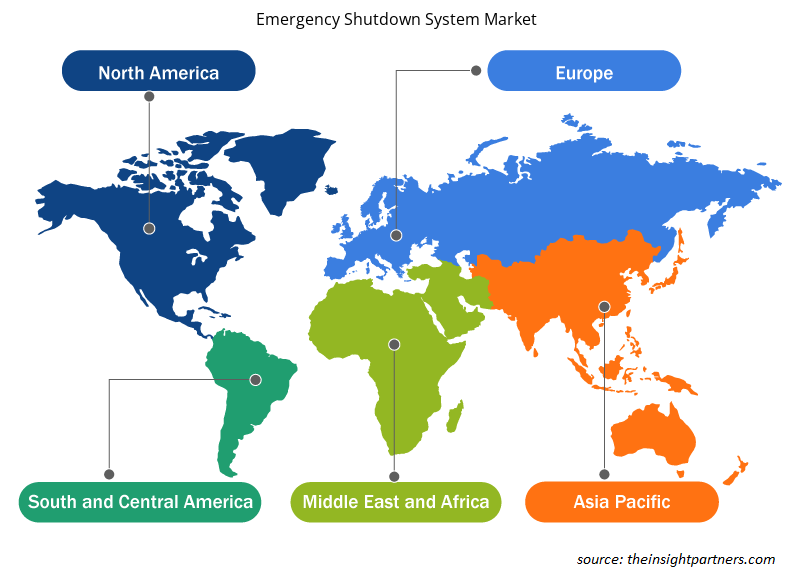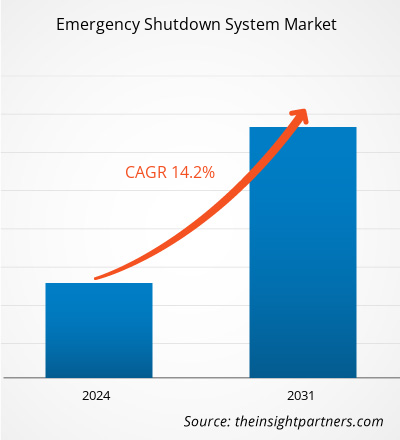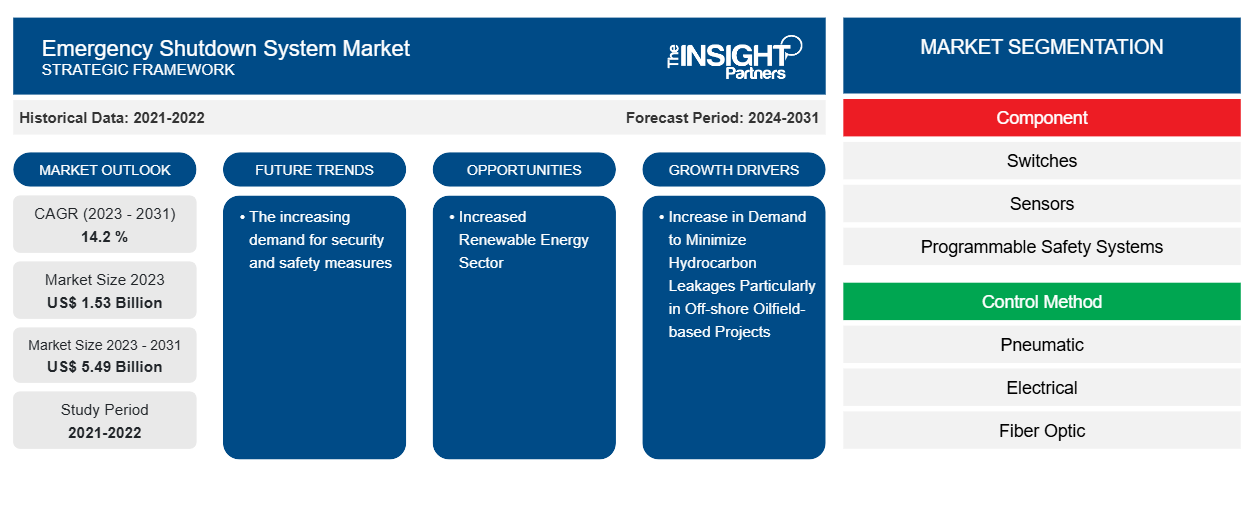Si prevede che la dimensione del mercato dei sistemi di arresto di emergenza raggiungerà i 5,49 miliardi di dollari entro il 2031, rispetto ai 1,53 miliardi di dollari del 2023. Si prevede che il mercato registrerà un CAGR del 14,2% nel 2023-2031. È probabile che la crescente domanda di misure di sicurezza e protezione rimanga una tendenza chiave del mercato dei sistemi di arresto di emergenza.
Analisi di mercato del sistema di arresto di emergenza
Il sistema di arresto di emergenza è fortemente influenzato dalla forte presenza di grandi aziende in vari settori verticali dell'industria degli utenti finali, a causa dei loro processi industriali significativamente ampi dotati di varie soluzioni tecnologiche.
Panoramica del mercato dei sistemi di arresto di emergenza
Un sistema noto come sistema di arresto di emergenza, o ESD, viene impiegato in ambienti pericolosi per evitare scenari che potrebbero avere conseguenze disastrose per l'economia, l'ambiente o le operazioni. Prevenendo situazioni come perdite, fughe di idrocarburi, incendi ed esplosioni, sono realizzati per ridurre gli effetti di circostanze di emergenza, come danni alle persone o distruzione di apparecchiature. Caldaie, centrali elettriche a gas e a vapore , impianti di lavorazione di petrolio e gas e giacimenti petroliferi (teste di pozzi petroliferi) includono tutti meccanismi di arresto di emergenza.
Personalizza questo report in base alle tue esigenze
Riceverai la personalizzazione gratuita di qualsiasi report, comprese parti di questo report, o analisi a livello nazionale, pacchetto dati Excel, oltre a usufruire di grandi offerte e sconti per start-up e università
-
Scopri le principali tendenze di mercato in questo rapporto.Questo campione GRATUITO includerà analisi di dati che spaziano dalle tendenze di mercato alle stime e alle previsioni.
Driver e opportunità del mercato del sistema di arresto di emergenza
Aumento della domanda per ridurre al minimo le perdite di idrocarburi, in particolare nei progetti basati sui giacimenti petroliferi offshore
Lo scopo di un sistema di arresto di emergenza (ESD) è quello di ridurre gli effetti di situazioni generalmente collegate a inondazioni incontrollate, fuoriuscite di idrocarburi o incendi in industrie pericolose o luoghi in cui sono presenti idrocarburi . Storicamente, l'analisi dei rischi ha dimostrato che il programma di arresto di emergenza necessita di un elevato grado di integrità della sicurezza (SIL 2 o 3). La logica del dispositivo per l'elaborazione del segnale in ingresso, sensori montati sul campo, valvole, relè di sgancio, avvisi e moduli HMI costituiscono la maggior parte del sistema. I diagrammi causa-effetto creati per l'installazione sono seguiti dal dispositivo durante l'elaborazione dei segnali di ingresso e l'attivazione delle uscite. Si prevede che le crescenti operazioni a monte e l'aumento dei prezzi del petrolio e del gas stimoleranno la domanda di sistemi di arresto di emergenza (ESD), in particolare da parte di strutture offshore. Le attività di raffinazione del petrolio a metà, a monte e a valle sono le principali fonti di domanda di ESD. Il settore petrolifero e del gas offshore negli Stati Uniti e in Europa è soggetto a restrizioni di sicurezza e ambientali applicate da leggi e regolamenti come il Bureau of Safety and Environmental Enforcement (BSEE). Per ridurre il rischio di incidenti o contrattempi, viene effettuato un attento monitoraggio della temperatura e della pressione.ESD) is to reduce the effects of situations that are generally linked to uncontrolled floods, the escape of hydrocarbons, or fire breakouts in hazardous industries or locations where SIL 2 or 3). Device logic for incoming signal processing, field-mounted sensors, valves, trip relays, warnings, and HMI modules make up the majority of the system. The cause and effect diagrams created for the installation are followed by the device when processing input signals and triggering outputs. Growing upstream operations and rising oil and gas prices are expected to drive up demand for emergency shutdown systems (ESDs), particularly from offshore facilities. Midstream, upstream, and downstream oil refinery activities are the primary sources of demand for ESDs. The offshore oil and gas business in the US and Europe is subject to safety and environmental restrictions that are enforced by laws and regulations such as the Bureau of Safety and Environmental Enforcement (BSEE). Close monitoring is done of temperature and pressure to reduce the possibility of mishaps or accidents.
Aumento del settore delle energie rinnovabili
Il settore delle energie rinnovabili sta crescendo in modo significativo in tutto il mondo. Secondo il rapporto delle Nazioni Unite, le fonti di energia rinnovabili sono disponibili in ogni paese e il loro potenziale deve ancora essere sfruttato appieno. L'Agenzia internazionale per le energie rinnovabili (IRENA) stima che il 90% dell'elettricità mondiale possa e debba provenire da energie rinnovabili entro il 2050. Le fonti di energia rinnovabili forniscono un mezzo per sfuggire alla dipendenza dalle importazioni, diversificare le economie nazionali, proteggerle dalle fluttuazioni dei prezzi dei combustibili fossili e promuovere una crescita economica inclusiva, la creazione di posti di lavoro e la riduzione della povertà. I sistemi di arresto di emergenza sono utilizzati in questo settore per garantire operazioni sicure. Se si verificano condizioni pericolose, è necessario intervenire immediatamente. Un sistema di arresto di emergenza è utilizzato per arrestare l'impianto in uno stato sicuro e proteggere l'ambiente e le risorse.IRENA) approximates that 90 % of the world’s electricity can and should come from renewable energy by 2050. Renewable energy sources provide a means of escaping reliance on imports, diversifying national economies, shielding them from the volatile price fluctuations of fossil fuels, and promoting inclusive economic growth, job creation, and poverty reduction. The emergency shutdown systems are used in this sector to provide safe operations. If hazardous conditions occur, instant action should be taken. An emergency shutdown system is used to shut down the facility to a safe state and protect the environment and the assets.
Analisi della segmentazione del rapporto di mercato del sistema di arresto di emergenza
I segmenti chiave che hanno contribuito alla derivazione dell'analisi di mercato del sistema di arresto di emergenza sono i componenti, il metodo di controllo e il settore dell'utente finale (petrolio e gas, raffinazione, produzione di energia, chimica e altri)
- In base ai componenti, il mercato dei sistemi di arresto di emergenza è segmentato in interruttori, sensori, sistemi di sicurezza programmabili, valvole di sicurezza, attuatori e altri. Il segmento dei sensori ha detenuto una quota di mercato maggiore nel 2023.
- In base al metodo di controllo, il mercato è segmentato in pneumatico, elettrico, in fibra ottica e idraulico.
- In base al settore di utilizzo finale, il mercato è segmentato in petrolio e gas, produzione di energia, raffinazione, chimica e altri.
Analisi della quota di mercato del sistema di arresto di emergenza per area geografica
L'ambito geografico del report di mercato sui sistemi di arresto di emergenza è suddiviso principalmente in cinque regioni: Nord America, Asia Pacifico, Europa, Medio Oriente e Africa e Sud America/Sud e Centro America. In termini di fatturato, l'APAC ha rappresentato la quota di mercato più grande per i sistemi di arresto di emergenza. La regione APAC, a causa della forte presenza di piccoli e medi utenti finali non organizzati insieme a una limitata regolamentazione governativa, ha attribuito la bassa quota di mercato della regione nonostante la forte presenza di una base di utenti finali nella regione.APAC accounted for the largest emergency shutdown system market share. The APAC region, owing to the strong presence of unorganized small and medium end-users along with limited government regulation, has attributed the region’s low market share despite the strong presence of an end-user base in the region.
Notizie di mercato e sviluppi recenti del sistema di arresto di emergenza
Il mercato dei sistemi di arresto di emergenza viene valutato raccogliendo dati qualitativi e quantitativi dopo la ricerca primaria e secondaria, che include importanti pubblicazioni aziendali, dati di associazioni e database. Di seguito è riportato un elenco degli sviluppi nel mercato dei disturbi e delle strategie del linguaggio e della parola:
- A marzo 2023, l'US Chemical Safety and Hazard Investigation Board (CSB) ha emesso un nuovo avviso di sicurezza intitolato "Pericoli posti dagli scarichi dai sistemi di scarico della pressione di emergenza". L'avviso del CSB evidenzia i pericoli identificati con i sistemi di scarico della pressione di emergenza da quattro indagini del CSB. L'avviso informa le strutture che, mentre uno scarico dai sistemi di scarico della pressione di emergenza può aiutare a proteggere le apparecchiature da eventi di alta pressione imprevisti e indesiderati, può anche danneggiare gravemente o mortalmente i lavoratori e causare danni estesi a una struttura se lo scarico non viene effettuato in un luogo sicuro. (Fonte: US Chemical Safety Board, comunicato stampa)CSB) issued a new Safety Alert titled “Hazards Posed by Discharges from Emergency Pressure-Relief Systems.” The CSB’s alert highlights hazards identified with emergency pressure-relief systems from four CSB investigations. The alert advises facilities that while a discharge from emergency pressure-relief systems can help protect equipment from unexpected and undesired high-pressure events, it can also seriously harm or fatally injured workers and cause extensive damage to a facility if the discharge is not made to a safe location. (Source: U.S. Chemical Safety Board, Press Release)
Copertura e risultati del rapporto di mercato sul sistema di arresto di emergenza
Il rapporto "Dimensioni e previsioni del mercato del sistema di arresto di emergenza (2023-2031)" fornisce un'analisi dettagliata del mercato che copre le seguenti aree:
- Dimensioni e previsioni del mercato a livello globale, regionale e nazionale per tutti i segmenti di mercato chiave coperti dall'ambito
- Dinamiche di mercato come fattori trainanti, vincoli e opportunità chiave
- Principali tendenze future
- Analisi dettagliata delle cinque forze PEST/Porter e SWOT
- Analisi di mercato globale e regionale che copre le principali tendenze di mercato, i principali attori, le normative e gli sviluppi recenti del mercato
- Analisi del panorama industriale e della concorrenza che copre la concentrazione del mercato, l'analisi della mappa di calore, i principali attori e gli sviluppi recenti
- Profili aziendali dettagliati
Ambito del rapporto
Approfondimenti regionali sul mercato dei sistemi di arresto di emergenza
Le tendenze regionali e i fattori che influenzano il mercato dei sistemi di arresto di emergenza durante il periodo di previsione sono stati ampiamente spiegati dagli analisti di Insight Partners. Questa sezione discute anche i segmenti e la geografia del mercato dei sistemi di arresto di emergenza in Nord America, Europa, Asia Pacifico, Medio Oriente e Africa e America meridionale e centrale.

- Ottieni i dati specifici regionali per il mercato dei sistemi di arresto di emergenza
Ambito del rapporto di mercato sul sistema di arresto di emergenza
| Attributo del report | Dettagli |
|---|---|
| Dimensioni del mercato nel 2023 | 1,53 miliardi di dollari USA |
| Dimensioni del mercato entro il 2031 | 5,49 miliardi di dollari USA |
| CAGR globale (2023-2031) | 14,2% |
| Dati storici | 2021-2022 |
| Periodo di previsione | 2024-2031 |
| Segmenti coperti |
Per componente
|
| Regioni e Paesi coperti |
America del Nord
|
| Leader di mercato e profili aziendali chiave |
|
Densità degli attori del mercato: comprendere il suo impatto sulle dinamiche aziendali
Il mercato del sistema di arresto di emergenza sta crescendo rapidamente, spinto dalla crescente domanda degli utenti finali dovuta a fattori quali l'evoluzione delle preferenze dei consumatori, i progressi tecnologici e una maggiore consapevolezza dei vantaggi del prodotto. Con l'aumento della domanda, le aziende stanno ampliando le loro offerte, innovando per soddisfare le esigenze dei consumatori e capitalizzando sulle tendenze emergenti, il che alimenta ulteriormente la crescita del mercato.
La densità degli operatori di mercato si riferisce alla distribuzione di aziende o società che operano in un particolare mercato o settore. Indica quanti concorrenti (operatori di mercato) sono presenti in un dato spazio di mercato in relazione alle sue dimensioni o al valore di mercato totale.
Le principali aziende che operano nel mercato dei sistemi di arresto di emergenza sono:
- ABB Ltd
- Società internazionale Cameron
- Azienda Emerson Electric
- Compagnia elettrica generale
- Honeywell International Inc.
- National Oilwell Varco Inc.
Disclaimer : le aziende elencate sopra non sono classificate secondo un ordine particolare.

- Ottieni la panoramica dei principali attori del mercato dei sistemi di arresto di emergenza
- Analisi storica (2 anni), anno base, previsione (7 anni) con CAGR
- Analisi PEST e SWOT
- Valore/volume delle dimensioni del mercato - Globale, Regionale, Nazionale
- Industria e panorama competitivo
- Set di dati Excel
Report recenti
Rapporti correlati
Testimonianze
Motivo dell'acquisto
- Processo decisionale informato
- Comprensione delle dinamiche di mercato
- Analisi competitiva
- Analisi dei clienti
- Previsioni di mercato
- Mitigazione del rischio
- Pianificazione strategica
- Giustificazione degli investimenti
- Identificazione dei mercati emergenti
- Miglioramento delle strategie di marketing
- Aumento dell'efficienza operativa
- Allineamento alle tendenze normative























 Ottieni un campione gratuito per - Mercato dei sistemi di arresto di emergenza
Ottieni un campione gratuito per - Mercato dei sistemi di arresto di emergenza